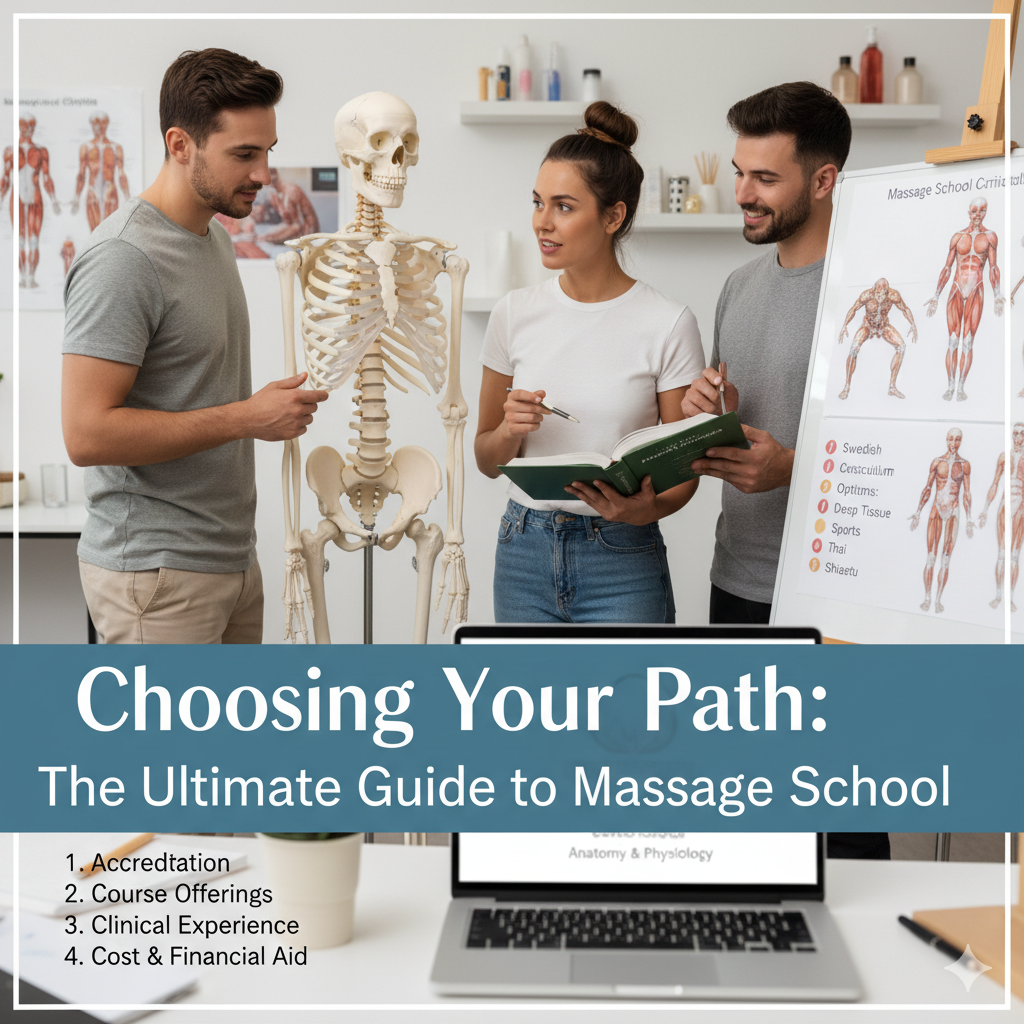So, you’ve decided you want to become a massage therapist—congratulations! 🎉 Choosing to find a massage school is the very first step in building a rewarding career where you’ll help people feel better in their bodies. Before you can get licensed and start working with clients, you need to complete your accredited hours. The massage school you choose can shape your entire journey.
I remember when I was researching how to find a massage school—I didn’t realize how many options were out there. I thought massage was massage, right? Not quite. Depending on where you live, the choices can feel overwhelming. But if you break them down into a few key considerations, the decision becomes much clearer.
Here’s what to keep in mind when you’re looking to find a massage school that’s right for you:
Location of the Massage School
Let’s start with the practical stuff. Where the school is located matters more than you think. A long commute might not seem like a big deal at first, but when you’re balancing classes, practice hours, and possibly a job or family, those extra miles can wear you down.
Ask yourself:
- Is the school close enough to fit into my daily routine?
- Can I realistically manage the commute for the length of the program?
Sometimes, the best choice is simply the one that’s convenient and sustainable for your lifestyle.
Full-Time vs. Part-Time Massage Therapy Program
Massage school is a big commitment, and how you schedule it makes all the difference.
- Full-time programs are immersive and move quickly. You’ll finish sooner, but you’ll need the time and energy to commit fully.
- Part-time programs stretch out the timeline, but they give you flexibility if you’re working or caring for family while in school.
When I attended massage school, I drove about 30 minutes and chose the part-time, 11-month program. I worked while in school, and I also knew I needed adequate study time to retain the material. That balance worked for me—I graduated with a 4.0 and made the Dean’s List.
There’s no “right” choice—only the one that fits your life right now.
Massage Modalities: Western, Eastern, or Both?
Massage therapy is a broad field, and schools often focus on different philosophies.
- Western modalities (like deep tissue, sports massage, or medical massage) are common in clinical and therapeutic settings.
- Eastern modalities (like shiatsu, Thai massage, or reflexology) take a holistic approach, often emphasizing energy flow and balance.
- Many massage schools offer a blend of both, giving you a versatile foundation.
I chose a Western-focused school, since my goal at the time was to provide corporate chair massage. Your chosen modalities will reflect the type of clients you attract. For example, athletes may gravitate toward Western-based therapy, while clients interested in energy healing may seek Eastern approaches.
The beauty of this career is that you can always expand your skills with continuing education in massage therapy. Over the years, I’ve discovered energy work, and it’s now one of my passions.
Massage School Costs and Financial Planning
Education is an investment, and massage school tuition varies widely. Planning ahead will save you stress down the road.
- Paying upfront eliminates debt later.
- School loans or financing can make costs manageable, but you’ll need a clear budget for repayment.
- Don’t forget about hidden costs: books, supplies, state exams, licensing fees, and liability insurance. Some schools include these in tuition, but not all—ask upfront.
When I enrolled, my tuition included books, final exams, and a professional massage table. Make a checklist of what your tuition covers before you commit.
Final Thoughts on How to Find a Massage School
Selecting the right massage school is about more than technique—it’s the foundation of your career. Take time to research programs, visit campuses, and talk to current or former students.
The right accredited program won’t just help you pass exams; it will also prepare you to build a sustainable massage therapy business you’ll love.
And remember, this is only the beginning. Once your education is in place, you’ll be ready for the next step: building your brand, finding clients, and creating a thriving practice. I’ll be covering all of that in future posts, so stay tuned.
Here’s to your journey—one step at a time. 🌿
Did you like this article? Try Beginner’s Guide to Starting a Massage Business (From a Therapist Since 2009)




Hi Claire, thanks so much for this insightful and encouraging post! As someone who’s considering a career change into massage therapy, this guide is exactly what I needed.
I really appreciated your point about how the right school can lay the foundation for a sustainable business. It’s easy to get caught up in just finding a program that meets the state’s required hours, but you’re right—it’s about so much more. Your tips about looking at different **modalities** and thinking about **hidden costs** are especially helpful.
I’ve also been thinking a lot about **accreditation** and its importance for licensing and credibility. I’m wondering if you have any advice on what to look for besides what’s listed on a school’s website? For example, are there specific questions I should ask about **job placement rates**, **MBLEx pass rates**, or **alumni networks**? Any tips on what red flags to watch out for would be great too!
Thanks again for all the wonderful, free information you’re providing. I’m excited to follow your future posts!
That was a great article, Claire! It really breaks down the decision-making process for finding the right massage school, which can feel incredibly daunting. Your personal experience—especially balancing a part-time program with work and graduating at the top of your class—is very motivating.
I especially appreciate the practical advice about **location and commute**. That’s something easy to overlook when you’re excited, but a miserable commute can definitely sabotage your commitment.
Also, your section on **Western vs. Eastern modalities** is super helpful. It makes me think I should try to get some introductory bodywork sessions (like deep tissue *and* Thai massage) before enrolling so I can better understand which philosophy truly resonates with my goals for working with clients.
Since your blog is focused on building a business, I’d be curious to hear your thoughts in a future comment or post about **student clinic experience**. Does the quality and volume of hands-on practice in the school’s clinic significantly impact a new therapist’s confidence and ability to secure their first clients right out of school?
Thanks again for creating this valuable resource! I’m looking forward to reading your posts on building a brand and finding clients. 🌿